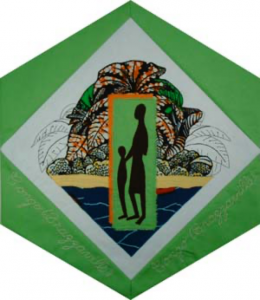Congo

The Block
Susan Towndrow designed this block based on a scene described by Marie-Léotine Tsibinda. The piece, which reflects Marie Léotine’s strong feelings for the landscape and art of her birth-country, is a stylized rendering of a treasured carving she brought from Congo-Brazzaville. In the foreground, an appliquéd image of mother and child, symbolic of a mother’s deep love for her children, seems to emerge from the lush jungle onto a sandy beach, while the background fabrics typify the cotton prints of West African design.
Cultural Profile
Once known as Middle Congo, The Republic of the Congo (Congo-Brazzaville) adopted its current name after achieving independence from France in 1960. This developing nation is located in central West Africa, bordered by Gabon, Cameroon, Democratic Republic of the Congo and Angola. It is also bounded to the south and east by the Congo River, along which its capital city, Brazzaville, is situated and mirrored on the other side of the river by Kinshasa, the Democratic Republic of Congo’s capital. The river is not totally navigable due to rapids, but its many tributaries still serve as a transportation system through the country’s dense, tropical forests and wooded savannahs. Since Congo-Brazzaville straddles the equator, the temperature here is generally hot, the air humid and the rainfall heavy.
A variety of ethnic groups including the Kongo (48%), the Sangha (20%), the Teke (17%) and the M’Bochi (10%) make up the country’s population. 70% of the inhabitants, most of whom are involved in either agriculture or handicrafts, live in the area along the Congo River that stretches from Brazzaville to the coastal Pointe-Noire. French is the official language and is used in the education system, although some 69 indigenous tongues and dialects––Kikongo being the widest-spread––are also spoken.
The culture of Congo-Brazzaville is a vibrant array of sounds, colours, textures and tastes. Woodcarving traditions of the different ethnic groups are highly valued. The Bembe are known for their bimbi figurines with geometric carvings representing scarifications while the Teke are known for their disc-shaped masks and their yellow copper metalwork. The Bakongo bowls, scepters or fetishes, are also sought-after items. Malachite, a mineral readily available in the area, is also used to carve beautiful boxes.
Clothing is an important part of the Congoleses’ social status; garments must be clean and pressed on most occasions. The country is home to the Société des ambieuceurs et des personnes élégantes, the SAPE, a clothing movement owing to dandyism. Both men and women (called sapeurs) claiming allegiance to this movement wear elegant, yet over-the-top suits and dresses, sunglasses (regardless of the hour of the day), and costly shoes. These extravagant clothes are ordered from France or made locally as the sapeurs’ goal is to dazzle onlookers. The sapeurs are in fact so popular that some even ‘rent’ their services to attend parties, making it an event for guests to remember. The movement is also popular in France, a country where many Congolese immigrate to find work.
In 1951 Brazzaville’s Poto Poto Painting School was founded by French expatriate Pierre Lods to support authentic African artistic expression. Today, artists from this school produce works inspired by their culture, environment and traditional styles of decorated handcrafts. In addition, great literary works have risen out of troublesome times through the words of accomplished authors, such as Sylvain Bemba, Sony Labou Tansi and Gerald Felix Tchicaya U Tamsi.
Congolese have been coming to Canada since the 1970s, often times to escape the recurring civil unrest of their homeland.
Sponsor: Elizabeth Ferguson
